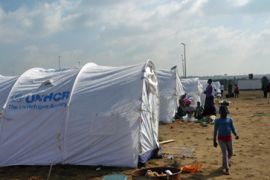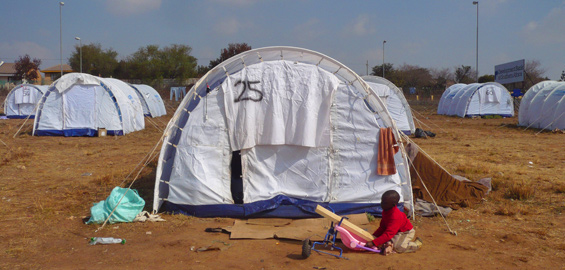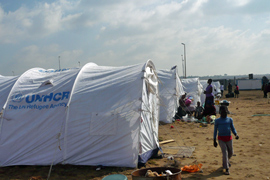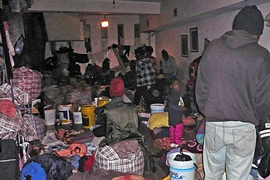South Africa’s displaced in limbo
Two months after xenophobic attacks, tens of thousands remain uncertain of future.


Thousands of people remain displaced long after the eruption of the violence
The 30 children at the Mid Rand camp would rather be anywhere but “home”.
They are part of a crowd of more than 650 people sharing tents on a patch of land to the east of Johannesburg.
But this is no festival event with camping provided.
The arid territory holds rows of bright white United Nations Refugee Agency (UNHCR) tents.
This is their refuge after xenophobic attacks, which began about two months ago, forced them from their residences.
It is one of scores like it set up around South Africa since May.
The tents’ tarpaulin provides little protection against the low night temperatures, nearing 0 Celsius this winter, and the dampness that rises from the ground.
However, it is not enough to persuade Lucky, a 12-year-old native of Mozambique who fled his home in Kanana, in the East Rand, to return to that area of Johannesburg.
He says that going home would be worse than the camp as it was his neighbours who told gangs that his family were from Maputo, the capital of Mozambique.
Lucky fled when the groups arrived and began looting homes.
Beatings
“The criminals were beating my aunt, father and mother. I was worried for our shack as they were breaking everything,” he says.
The family managed to escape and ran to a police station, but they lost all of their possessions.
“I was very, very sad and I didn’t know why someone who is the same as me would do this. I still think about it today,” the boy says.
The violence, in which 62 people died and more than 100,000 were displaced, was not confined to immigrants.
Tina was born in South Africa, as was her father. However, her Mozambique mother and the fact that her father grew up near the border to the country were enough to make them targets too.
The 12-year-old’s sense of security in Kanana, from where she fled, has been shattered.
“I saw people burning shacks. They wanted to burn the people so we ran away.
“I don’t want to go back. I want to find a better place. The families of the criminals who are now in prison will come and try and burn us again if we go back,” she says.
Trauma
 |
| About 650 people are staying in the Mid Rand camp to the east of Johannesburg |
What the children speak about most is their desire to return to school, but this is problematic.
Lucky says he does not want to return to his old school as some of the people involved in the violence are there.
And whereas he could previously walk to his classes from home, he is now about 20km away.
The government promised that buses would be provided to take children from the camps to school but they have not shown up.
Andy Stitz, who is producing a documentary on children in the camps for a human rights organisation, says varying degrees of functional difficulties and trauma are now apparent.
“Having lost everything in the violence the children have no school uniforms. The Department of Education has not kept its promise to provide these. So even if they do go to school there would be a feeling of being the outsider,” Stitz says.
She adds that while some children are upset because they have left possessions behind, for others the violence has been an exacerbation of distress.
“I spoke to one eight-year-old girl from the Democratic Republic of Congo who told me that she had seen her friend killed in front of her before her family fled from violence there to South Africa.
“After this second set of traumatic events she is very quiet and keeps everything within.”
Stitz says that without counselling, “there is a sense to me of someone like her being a time bomb”.
Poor conditions
With an estimated 50,000 people in refugee camps around the country – tens of thousands having already returned to their native countries – poor living conditions add to the problems.
Abigail Jaravaza, 26, fled her home in Johannesburg’s Alexandra township – where the violence started – after she came back from work to find that it had been set on fire.
With her four-year-old son the native Zimbabwean found refuge in the Central Methodist church in the city’s central business district.
With nearly 2,000 refugees – displaced for varied reasons – taking sanctuary over the building’s three floors, the air inside is heavy with the smell and taste of dirt, sweat and body heat.
Residents have the opportunity to bathe every two or three days and food is rationed to mothers and their children receiving at most a twice daily offering of porridge.
Among the stairwells crammed with people under blankets and constant coughing it is perhaps unsurprising that this is where Abigail’s son contracted TB.
He receives free medical care from the government and Medecins Sans Frontieres, the international aid organisation, and broadly the business community and local communities have been generous.
Millions of dollars have been donated and essentials such as blankets and clothes provided.
Missing policy
But the slow pace of the South African government’s policy making with regards to victims of xenophobic violence means many remain afraid and uncertain.
A two-month expiry date given by the government to camps they set up after the violence is up at the end of July. Yet, there has been no word as to what refugees are to do once this time comes.
 |
| People in the Central Methodist Church live in cramped and dirty conditions |
Siobhan McCarthy, the chief director for communications at the ministry of home affairs, says the decision is “with the political leadership”.
“There will be a proposal tabled to the cabinet so we [and other departments] are waiting for direction from them.
“There is a clear need for a review of policy, but what direction or outcome that policy will take we don’t know.”
Some of the victims have received temporary ID cards to replace those lost in the violence. But these only last for six months, adding to the uncertainty regarding victims’ futures.
Many whose native countries suffer unrest, particularly Zimbabwe, are caught between a rock and a hard place.
Tough decision
Loren Landau, director of the forced migration programme at the University of the Witwatersrand, says “the government has said that there is going to be a solution but we don’t know what yet and it is unclear who will carry it out”, whether it is the home affairs ministry or the local government.
“And with ID cards being valid for six months it is unclear whether people will be told to stay or go.”
Landau says that if the government does not act to combat the root causes of the violence then the problem is going to return.
“There is a longstanding dislike for foreigners, manifesting itself in the recent violence.
“It is political symbolism: a way of expressing distaste of poverty, dislike of government assistance and increases in oil and food prices. Because the government is inaccessible they are taking their unhappiness out on another vulnerable group, knowing that they will get away with it,” she says.
She adds that the government has done little to change foreigners’ legal status or immigration laws to make them more accepted in South Africa or integrate them into communities.
If they remain viewed as alien parasites – blamed for fuelling unemployment and crime – then an already divided society will be fractured even more.